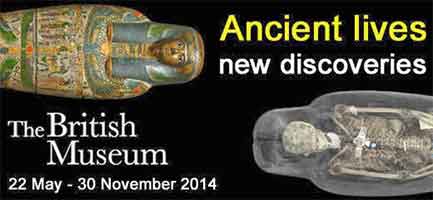Egyptian Ancient lives examined by CT Scans

Teeth with abscesses and poor state, cardiovascular diseases
by Francesco Carelli
Professor in Milan, Rome
The British Museum has always sought new ways to explore its collection, using the latest scientific techniques to shed new light on ancient cultures. This ground-breaking, interactive exhibition showcases recent research on one of the most-popular areas of the collection – ancient Egyptian and Sudanese mummified remains or ‘mummies’.
Ancient lives, new discoveries, uses state-of-the-art technology to allow visitors to virtually explore inside mummy cases and examine the bodies underneath the wrappings, bringing us face to face with eight people who lived in the Nile Valley thousands of years ago.
The Museum is known for its innovative research and use of cutting-edge visualisation in this field. The first mummy entered the Museum’s collection in 1756, but for the past 200 years none of the mummies have been unwrapped, so technology has been critical to improving our understanding of ancient cultures. A full x-ray survey of the mummies in the 1960s was followed in the 1990s by the pioneering use of hospital CT scanners.
Now innovative advances in medical science and engineering technology can be applied to the study of ancient human remains. The most recent scans undertaken have used the new generation of medical CT scanners, capable of producing data of unprecedented high resolution. The transformation of this data into 3D visualisations has been achieved with volume graphics software usually used in other fields such as car engineering. Visitors will be able to view and interact with this data to discover details of the lives of these individuals.
The exhibition is structured around eight mummies which have been the focus of recent scientific investigation. Each mummy is accompanied by large-screen visualisations which journey into the body, through the intact wrappings to reveal the mummified remains, skeleton and the secrets of mummification. The digital displays, some of them interactive, also focus on newly discovered aspects revealed by the scans.
The mummies selected cover a time-span of over 4000 years, from the Predynastic period to the Christian era, from sites in Egypt and the Sudan. The emphasis is on revealing different aspects of living and dying in the ancient Nile Valley through these eight individuals and also through contextual objects from the collection such as amulets, canopic jars, musical instruments and items of food. Mummification was used by people at different levels of society and was not just the preserve of pharaohs.
The eight individuals include:
An adult male villager from Gebelein who has been naturally preserved by the hot arid sand in the Predynastic period (c4400-3100 BC), before the time of the pharaohs.
An adult male from Thebes mummified c600BC. The CT data reveals details of the process that has been applied to preserve this body – the brain and the internal organs have been removed, and the soft tissues are in good condition. A specially designed visualisation shows the man’s head on three sides of a large cube screen. His teeth were in a poor state and a 3D replica of his lower mandible –based on the scan data – shows two large dental abscesses.
A female adult temple singer from Thebes, mummified c900BC, whose body reflects the highest level of mummification available at its period. This elite burial involved the ritual placement of amulets and other magical trappings on the body. An interactive digital visualisation allows visitors to examine the ornaments revealed by CT scans. The CT scan data was also used to print 3D replicas of the amulets. She may also have suffered from cardiovascular disease as the arteries in her legs are covered in calcified plaques.
A temple doorkeeper from Thebes, adult male, c700BC. CT scanning reveals that in preparation for this burial the head was detached from the body, and crudely held in position with wooden poles. This unorthodox mummification contravened the special emphasis placed in texts such as the Book of the Dead on ensuring the physical integrity of the corpse.
A child temple singer embalmed at 7 or 8 years of age, c800BC. Embalming was unusual for someone so young. The accompanying digital visualisation reveals developing teeth and well-preserved long hair. Also displayed are musical instruments such as a harp and bone clappers, as well as objects associated with hair and grooming, including a very rare wig.
An unknown man of high status, c1st-3rd centuries AD, mummified in distinctive manner, with arms, legs, fingers and toes separately wrapped, facial features painted on the wrappings, natural hair left uncovered, small fragments of gold leaf still preserved on the external surface, and decorative trappings added externally. The interactive visualisation shows the mummy being gradually unwrapped.
A 2 to 3 year old male child from the Roman era, c1st Century AD, positioned with his head tilted forward, characteristic of the Roman period. Objects relating to childhood, such as a toy horse, are also displayed.
A Sudanese female villager from a medieval Christian community, c700AD, whose body was naturally mummified in the unique environmental conditions in the Nile valley. The analysis of this mummy has revealed the use of Christian imagery in a tattoo found on the inner thigh, representing a monogram of the Archangel Michael, patron saint of the Sudan.
Neil MacGregor, Director of the British Museum said: “This new technology is truly ground-breaking, allowing us to reconstruct and understand the lives of these eight, very different, individuals. This is a project which has only been made possible through recent technological advances Technology can be used to help enhance learning potential”.

